Polycarbonate greenhouses: pros and cons
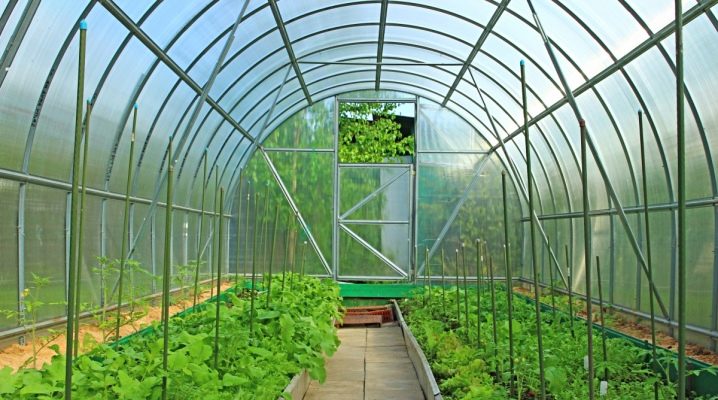
The principles of planning zones in a summer cottage are such that at least 50% of the land is allocated for vegetables and a garden. But many of the plants that you want to plant on your site are designed for a subtropical climate. They need warmth, light and moderate humidity. With a deficiency of these factors, the harvest is poor.
Experienced gardeners have long found a way out using greenhouses. Having evaluated all the pros and cons of this structure made of different materials, we can conclude that the best option is polycarbonate greenhouses.
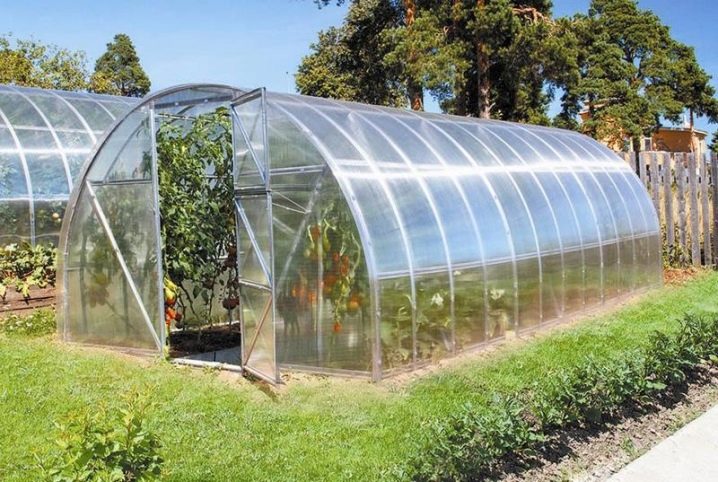
Peculiarities
A greenhouse is often confused with a greenhouse - a temporary one-season structure, the possibilities of which are severely limited. Unlike a simple greenhouse design - a frame and several layers of film, polycarbonate greenhouses have a number of distinctive features.
First of all, it is strength. The greenhouse has a strong metal frame, which is often purchased ready-made from the manufacturer. You can make the frame yourself from scrap materials, but without welding it will be less durable.
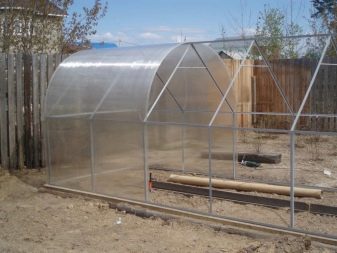

Part of the strength and stability of such a solid structure as a polycarbonate greenhouse provides the foundation.
Its presence determines another distinctive feature - the greenhouse is devoid of mobility. If a lightweight temporary structure made of hollow pipes and film can be rearranged from place to place, then the greenhouse is most often static.
Another feature is its large size. In the greenhouse, the gardener can stand at full height, move around calmly, without being constrained in movement. In addition, it accommodates a larger number of crops and it is possible to make several levels of plantings.

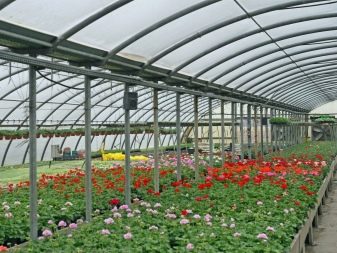
The microclimate inside the building can be maintained by the heating system. This is another factor that prevents it from being mobile. However, the presence of a heating system makes it possible to plant seeds directly into the ground in early spring. And due to the regulated level of heat, the range of crops grown is expanding. In a polycarbonate greenhouse, vegetables and greens grow beautifully, which are not intended for the changeable Russian climate.

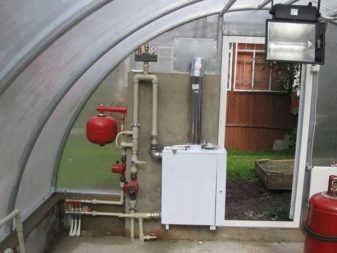
What distinguishes the greenhouse from open ground is that hot air accumulates in it. This obliges the gardener who mounts such a device on his site to make it high and equip it with opening windows in the roof or upper part of the walls.
Otherwise, instead of a rich harvest, there is a risk of not getting anything.
Also, ventilation should be provided in the structure, at least the simplest one, in the form of two doors from opposite ends of the building.
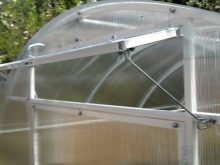
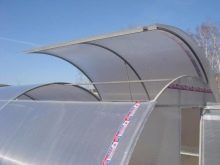
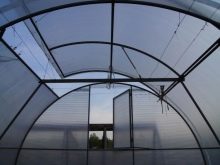
Advantages and disadvantages
You can build a greenhouse or greenhouse in your summer cottage using different materials: PVC film, glass, plastic, wooden and metal frame elements, various concrete bases. Depending on the type of material, the characteristics of the microclimate inside it will change.
Many gardeners are inclined to believe that polycarbonate is better than others for construction. It is flexible and resilient.This makes it possible to construct greenhouses of different geometric shapes with different types of roofs.
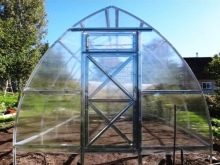
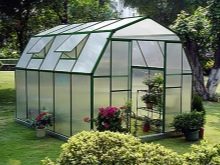
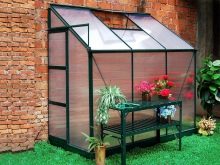
This material is durable and resistant to mechanical damage, does not freeze, does not crack with a sharp drop in temperature and humidity.
It is moderately transparent. This means that the plants will have enough light, but at the same time the sun's rays do not heat the greenhouse and do not affect the greenery like a magnifying glass, as it happens with glass structures.
The structure of the material is cellular or monolithic. It is recommended to choose a cellular (honeycomb) material for covering greenhouses. It provides voids and stiffeners, as in plastic windows. It is these air spaces within the cells that provide the unique characteristics of polycarbonate greenhouses. The air does not allow the room to lose heat and freeze.
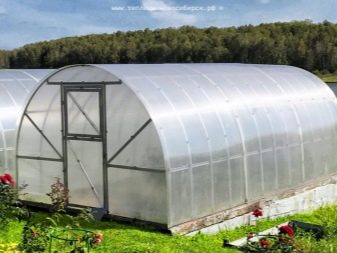
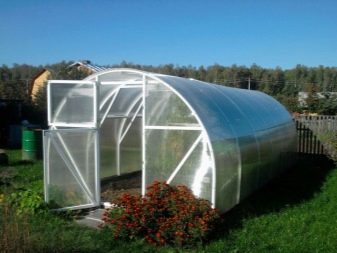
Polycarbonate is convenient to use in construction. It can be cut and bent without the risk of damaging the honeycomb structure. This makes it convenient for do-it-yourself frame sheathing.
Finally, the material looks aesthetically pleasing. Such a greenhouse does not have to be hidden in the depths of the site from prying eyes. It will look beautiful when using transparent polycarbonate or when choosing a colored material.
The color range of the material is very diverse. Polycarbonate sheets are available in clear, white, yellow, green, purple, orange, blue, red, and gray. The hue can be more or less saturated.
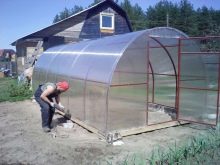
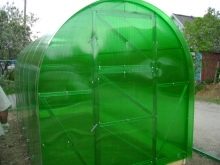
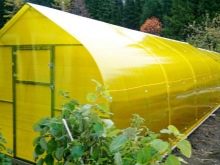
It is important to take into account that the addition of a paint pigment to the composition from which it is made is insignificant, but still reduces its resistance to freezing.
It becomes more fragile, therefore it is recommended to use a transparent or dim material.
The disadvantage of polycarbonate is the need for neat installation. Since open cells remain on the "cuts" of the sheets, water can get into them, and this will lead to freezing in winter. In this case, the material may be damaged and become unusable by the beginning of the gardening season.
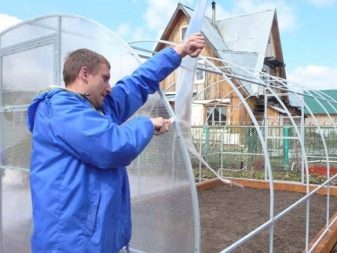
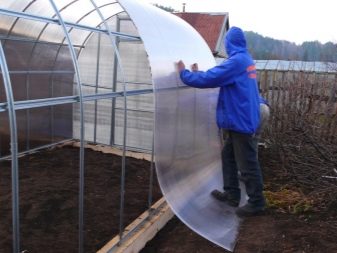
There is also a risk of damage to the material when using self-tapping screws as fastening the sheathing to the frame. In the place where the self-tapping screw enters the sheet, too large a hole or cracks can form, which reduces the effectiveness of the material. Moisture will enter through the cracks, and heat loss will increase.
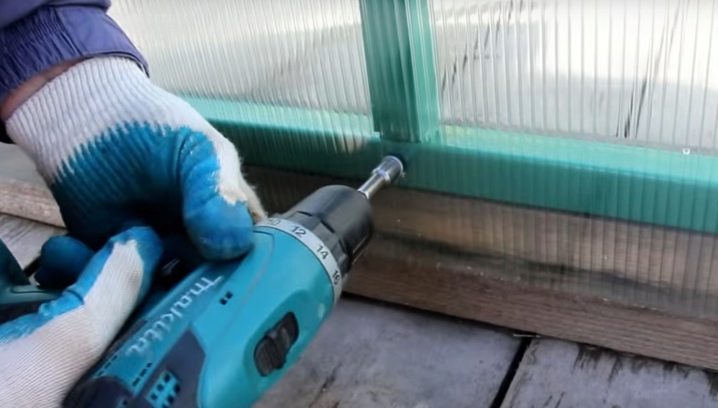
The pros and cons of polycarbonate as a building material determine the advantages of the design:
- In a greenhouse, a full cycle of crop growth is possible: from planting seeds in prepared soil to harvesting.
- A controlled microclimate for plants is created inside. In the cold season (early spring and late autumn), it is kept warm, and in the warm season, coolness is provided so that the greens do not dry out. The humidity level is regulated in the same way. No matter how dry or rainy the weather is, the plants in the greenhouse will receive as much moisture as they need.
- It becomes possible to grow crops that cannot be grown in the open field. These include even berries and fruits mainly from the southern regions of the country: grapes, watermelons, apricots, citrus fruits and other types.
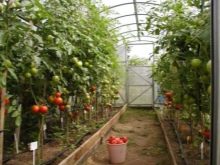
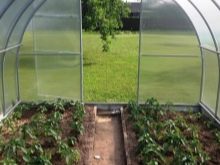
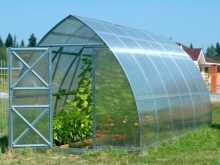
- Since you can start planting plants much earlier than the beginning of the season, and finish much later, the greenhouse provides its vegetables, berries and fruits not only in summer. You can get a crop in one place twice in one season. At the same time, the land must be fertilized and cultivated so that it remains fertile.
- Conditions are suitable for crossing different crops.
- The closed design protects plants not only from hypothermia or the scorching sun, but also from acid rain, wind, harmful insects, and dust.
- The transparent material transmits sunlight, but not harmful ultraviolet rays. This is facilitated by a special film coating.
- Polycarbonate has a long service life - 10-20 years.
- The greenhouse looks beautiful on the garden plot.
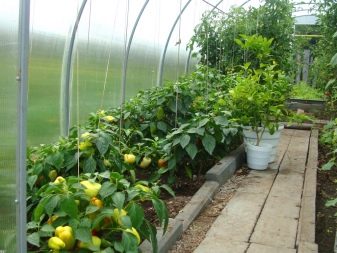
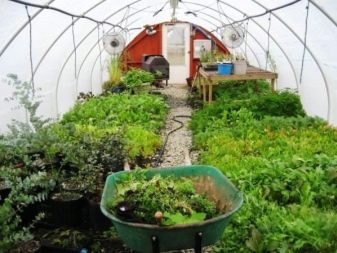
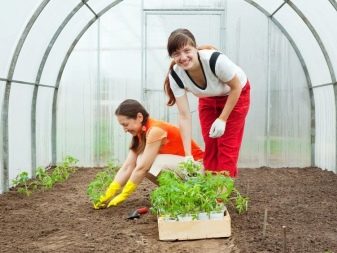
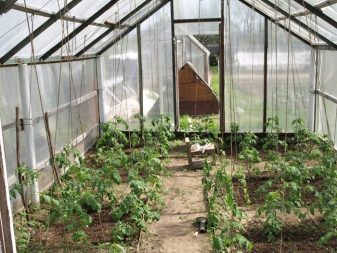
With all the positive aspects, the greenhouse has disadvantages.
- The structure must be well thought out, planned and assembled. This takes time, skills and significant financial costs.
- Polycarbonate is not scratch resistant.
- The presence of a light stabilizing layer (UV protection) makes the material less durable. Its service life is reduced by several years.
- In the open field, plants are pollinated by insects, without this there will be no harvest. In isolated conditions, you need to take care of how this will happen, or acquire self-pollinating plant varieties. If you do not keep track of the level of humidity and heat, the pollen will "damp" and the plant will not bear fruit.
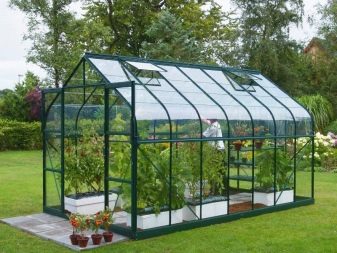
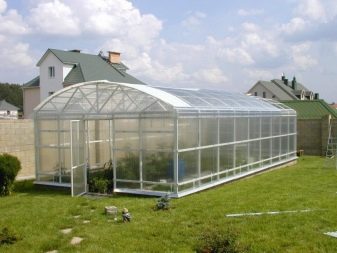
- The same plants cannot be grown in the greenhouse for two years in a row. This is due to the fact that cucumbers, tomatoes and other vegetables have different pests. If you change crops in places, the pests die, the plants are not harmed. If, year after year, the same crops are grown in one place, the harvest will deteriorate.
- Condensation can occur in a polycarbonate greenhouse if it is not properly assembled.
- Dark polycarbonate is less permeable to sunlight. This interferes with photosynthesis and good plant growth.
- The material expands and contracts with changes in ambient temperature. If this is not taken into account during construction, cutting out the material with a margin for expansion, in winter the greenhouse can crack at the places of folds and fastenings;
- Transparent polycarbonate becomes cloudy over time, and color fades. This is not the biggest problem against the background of the merits of the material, but as a result, the aesthetics of the building will suffer before the service life expires.

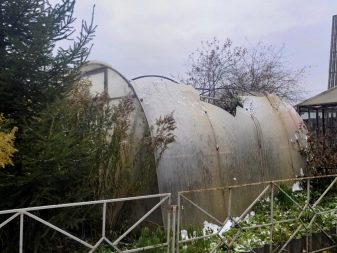
Views
An important stage in arranging a polycarbonate greenhouse is to choose a variety of this material.
The main criterion for this is the structure of the sheet. It can be monolithic (cast) or cellular (honeycomb).
Monolithic has a dense structure without an air gap. It can be smooth and wavy. In the first place in the list of its advantages is its aesthetic appearance - it looks like colored glass. When it comes to a greenhouse, it looks pretty unusual. In addition, the material is more resistant to scratches and damage, has greater strength and contributes to sound insulation. But for the rest of the characteristics, it is inferior to the cellular one. Due to its greater strength, it is more difficult to bend and cut, and sound insulation does not play a role in the greenhouse.
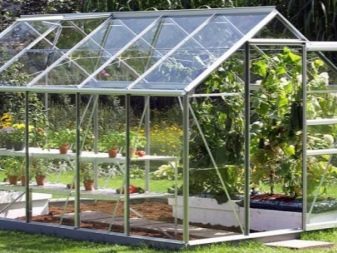
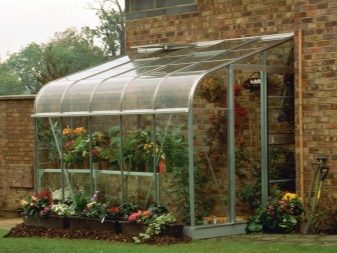
The structure of the honeycomb carbonate implies cavities and partitions within the sheet. On the cut, it resembles a honeycomb device, hence the name. Its thickness is 4-16 mm, depending on the type of sheet.
There are several types of sheet.
- 2H - panels consisting of two layers. Honeycomb inside in the form of rectangles. Stiffeners are simple partitions. The least resistant to the load from wet snow in winter, from mechanical stress they break faster than other types. Bend easily.
- 3H - three-layer panels with rectangular "honeycomb" and simple stiffening ribs. The ribs are vertical. Sheet thickness - 6, 8 and 10 mm. 6 mm sheets are suitable for double sheathing of the greenhouse frame.
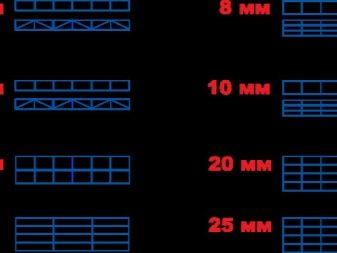
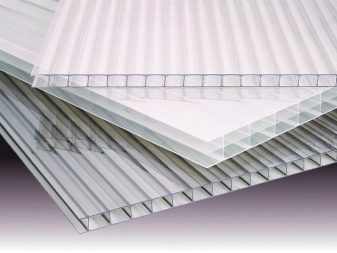
- 3X - three-layer sheets with combined stiffeners. Some are upright, others are inclined. The average sheet thickness is 12-16 mm. The best option for covering greenhouses.
- 5W - sheets of 5 layers with a rectangular mesh and vertical stiffeners. The thickness varies from 16 to 20 mm.
- 5X - five-layer sheets with straight and inclined stiffeners. They have the largest thickness - 25 mm. Suitable for covering greenhouses operating all year round and for arranging greenhouses in cold regions of the country.

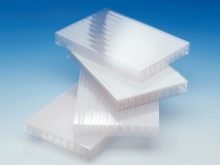
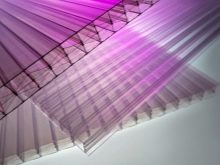
Cellular sheets are more suitable for arranging a greenhouse, since they slow down the process of heat loss and heating by the sun inside. They are more flexible than monolithic ones and weigh less.
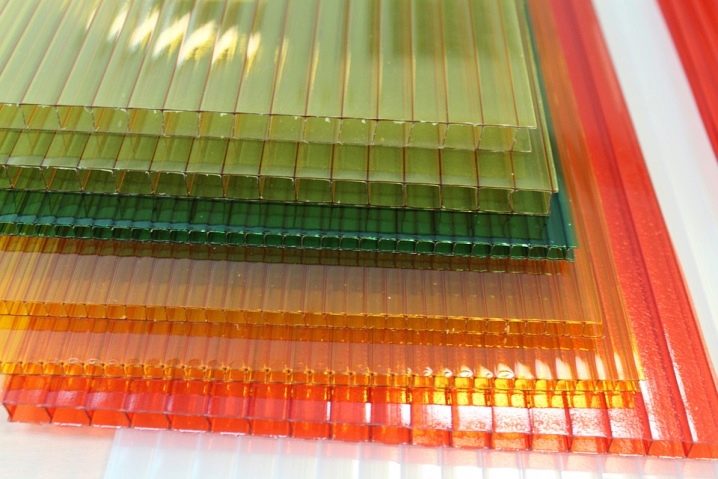
Constructions
Greenhouses are different in shape and type of construction.
In terms of shape, they distinguish buildings that are detached on the garden plot and wall-mounted. A wall-mounted greenhouse is usually combined with a country house on one of the sides.
The advantage of a back-to-wall greenhouse is that it freezes less in winter due to its location. It is also possible to lay the foundation for a greenhouse at the same time as building a house. This simplifies work and saves materials and space in a small area.

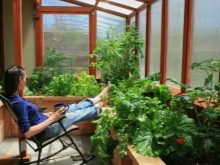
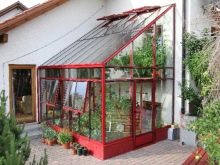
The disadvantage of the structure against the wall is that it is more difficult to organize uniform ventilation and air circulation in such a greenhouse.
In addition, constant humidity and heat inside the building negatively affects the condition of the wall of the house. And in winter, snow from the roof of the summer cottage can fall on the roof of the greenhouse. If not cleaned regularly, this can lead to the fact that the greenhouse will become unusable in a year or two.
There is also a division of structures into stationary and collapsible. Stationary greenhouses are more convenient, since they will need to be installed once every ten years.
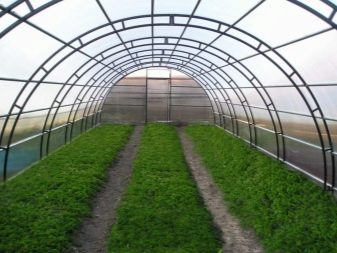

Collapsible ones also have their advantages: they can be moved from year to year to different places on the site, which will be useful for plants that cannot be planted in one place for two years in a row. Also, collapsible and sliding structures can be removed for the cold season and not worry about their safety.
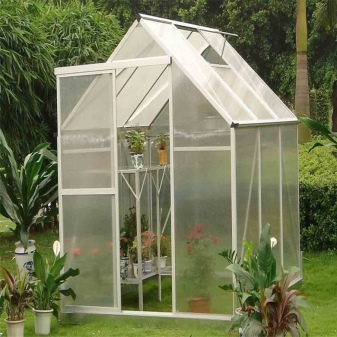
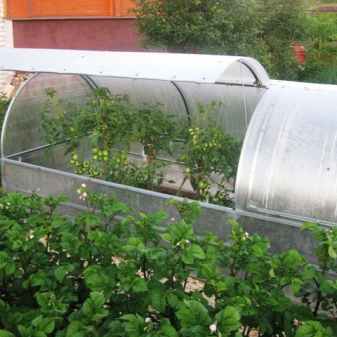
Foundation
The foundation is what makes the greenhouse stable, durable and different from other structures of a similar purpose. In addition to adding strength, it retains about 10% of the heat inside, protects the soil from being washed out by rain, and protects plants from frost.
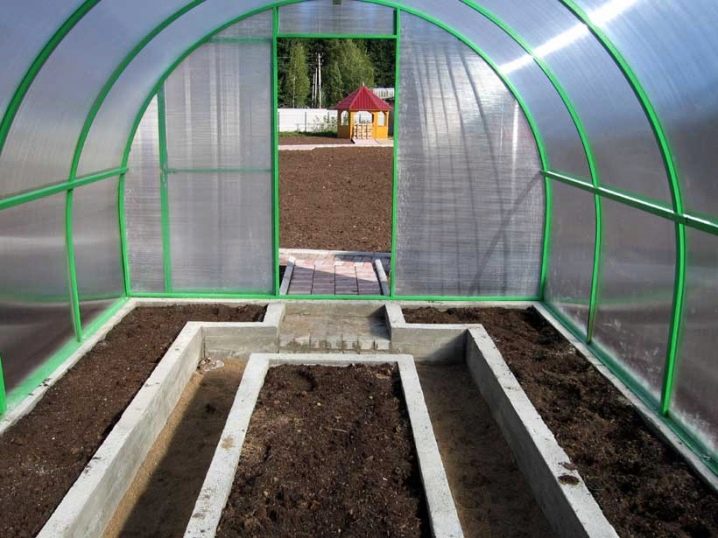
There are several types of foundations.
Solid
Such a foundation is considered the most laborious in the arrangement, since it completely overlaps the soil and requires anew to organize the fertile layer over the cement grout. It is necessary in areas where the groundwater rises too high, which is why the plants in the soil begin to rot. Also, with the help of a solid foundation, you can level out hilly areas of the earth.


It is done as follows: the fertile soil layer is removed, a depression is dug in the ground 15-20% larger in area than the greenhouse, sprinkled with sand and compacted tightly, waterproofing is laid. The layer of sand cushion should be 15-20 cm thick. Waterproofing on top is required - it will protect the foundation from destruction by groundwater. A frost-resistant cement foundation is poured over the waterproofing. The foundation itself must be reinforced with a metal mesh so that it does not crack under the weight of the greenhouse and the earth. A greenhouse can be installed on top.
Its height should take into account that a layer of fertile soil will be artificially formed on top of the cement. An alternative option for uneven terrain is a pile foundation.
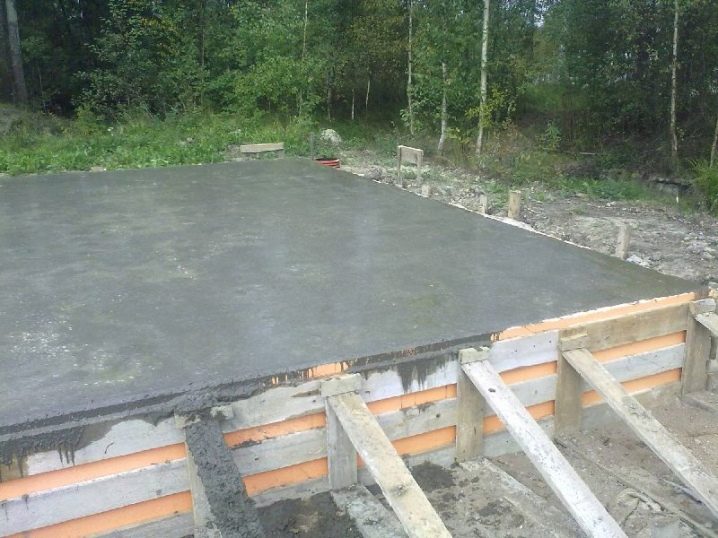
Tape
This type is much easier to create. A depression is dug in the ground (to the depth of soil freezing) according to the size of the greenhouse frame. Then these trenches are sprinkled with sand, equipped with waterproofing, and ready-made cement blocks are laid on top. They are strong enough, so the inner perimeter does not need to be poured.
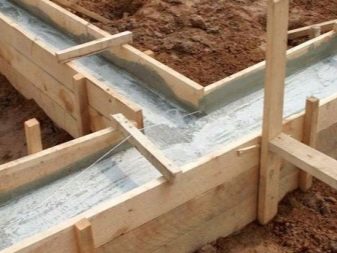
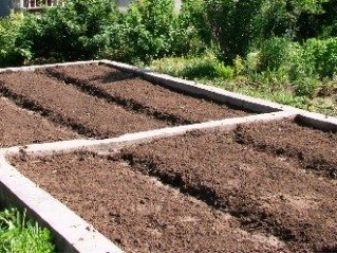
Columnar
For greenhouses, this option is rarely used, basically, it is necessary for arranging a gazebo in the country. The reason is that this method allows you to fill the foundation for structures of complex polygonal shapes, which is rarely the case for greenhouses.
The columnar foundation is laid almost identical to the strip foundation, but there is a slight difference. If the tape completely fills the grooves in the ground and the frame is in contact with it at all points of support, then the cement posts can be installed only at the corners of the frame. An important condition: the weight of the greenhouse must be small.
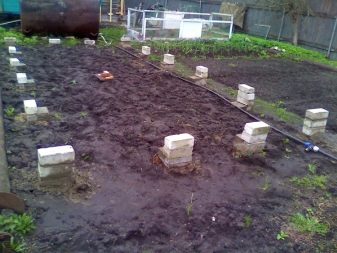

On a bar for wooden greenhouses
Not everyone buys ready-made metal frames. For those who assemble the frame by hand from wood, it is recommended to use a foundation made of the same material.Here you can use both timber with a special impregnation and sleepers treated with bituminous mortar.
At the corners of the wooden foundation, posts made of brick or concrete should be installed so that the structure does not sag.
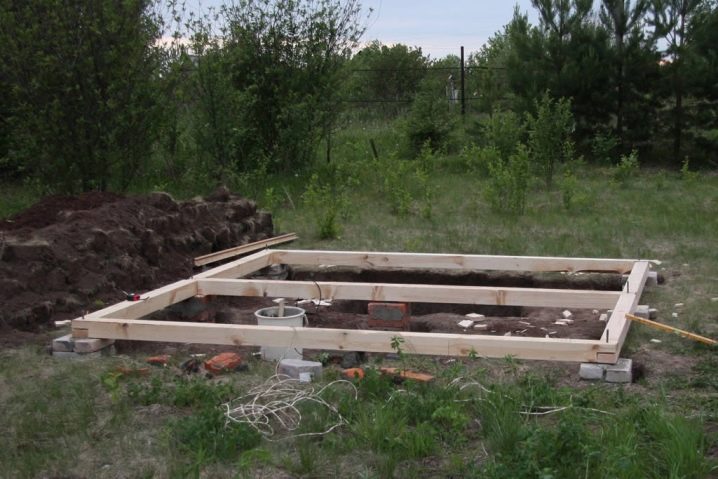
From available materials
The timber can be replaced with old pallets by impregnating them with a protective compound. A concrete foundation is a good substitute for car tires with large pebbles or rubble inside.
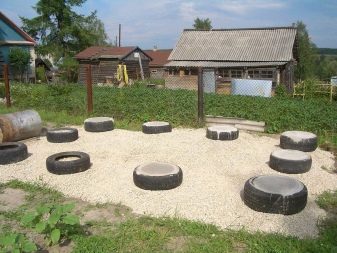
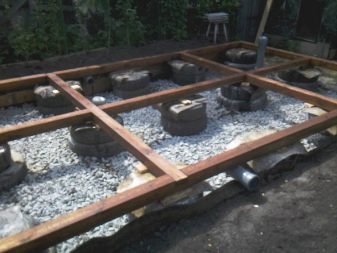
Frame
The choice of the basis of the entire structure must be approached wisely. There are two options for choosing a frame: assemble it yourself and purchase it ready-made.
Taking into account the fact that the production of greenhouse frames of various shapes and heights in our country is well established, the first option loses in all respects.

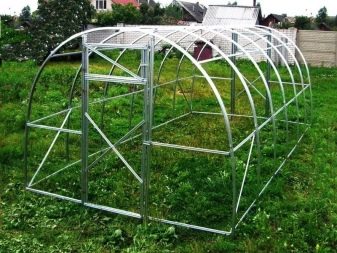
There are several reasons to choose a ready-made frame:
- it is a solid, sturdy construction that will last more than 20 years;
- the manufacturer gives a guarantee on it;
- the cost of consumables for the independent manufacture of the frame is equal to the cost of the finished product;
- buying a ready-made frame saves time and effort;
- the production possibilities are wider than with the independent manufacture of the frame, for example, purchase a greenhouse of the required height and width so that the microclimate inside is suitable for plants.
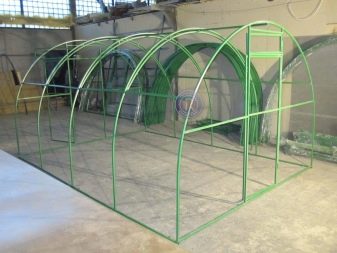
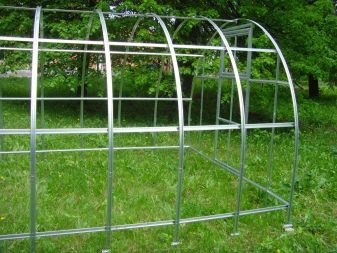
You can independently make a frame made of wood, galvanized profiles, PVC pipes.
The tree provides more options. The greenhouse will turn out to be of the same height, width and shape as it was intended.
A galvanized profile is more difficult to work with, since you need tools for metal processing. And a steel frame with your own hands cannot be made at all without special equipment with which you can bend, cut and weld it.
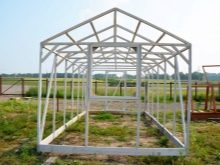
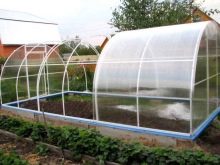
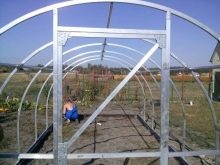
PVC pipes are easy to handle, but they impose many limitations. Only an arched greenhouse can be assembled from pipes and it will lose to other types in strength, stability and service life.
Therefore, the best solution is to purchase ready-made frames or factory-made collapsible greenhouses, which can be removed in the cold season for storage in a utility room.
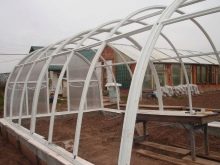
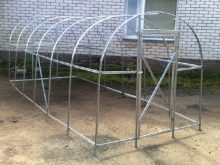

As for the shape of the greenhouse, it affects both the operation of the building and its aesthetic qualities.
It comes in different forms:
- rectangular;
- polygonal;
- pyramidal;
- arched.
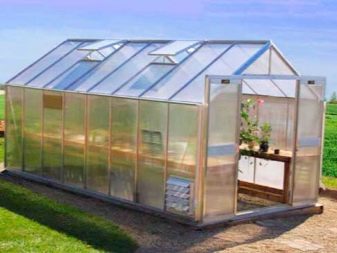

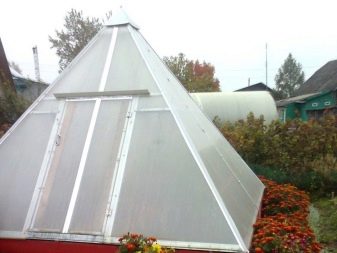

Each species has its own characteristics, advantages and disadvantages.
The arched greenhouse is the easiest to install. To mount it, you can use hollow aluminum pipes or PVC pipes. It will be possible to build a greenhouse with your own hands in one day, and you will not need as many materials as for a rectangular greenhouse.
But the pros end there.
The height of such a greenhouse does not allow hot air to rise up a long distance, which is why the plants in it begin to overheat. This reduces the yield.

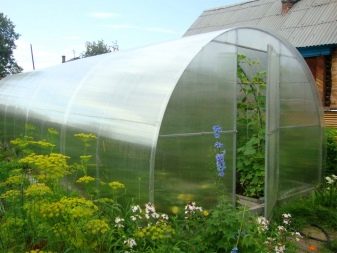
It will not work to work in full growth in such a greenhouse. Its maximum height is approximately 150-160 cm. This is below the average human height. It will also be problematic to plant tall plants in it, since they have nowhere to reach in a tight space.
A pyramidal greenhouse is a rarity on the site. Gardeners choose her as an experimental model. Such a greenhouse rarely has a foundation; temporary collapsible structures are more suitable.
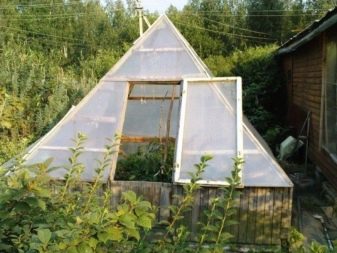
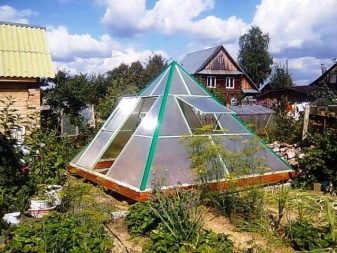
Pyramid greenhouses are convenient for experimenting with planting new plants.
Polygonal greenhouses look original and beautiful. In addition, their sophisticated design ensures that the sun's heat and light are evenly distributed throughout the day. But it is more difficult and more expensive to build such a greenhouse than an arched or rectangular one.
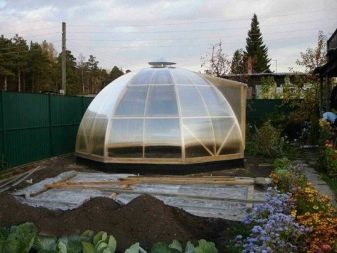
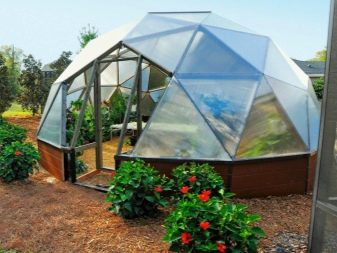
Rectangular house construction is the most common and convenient option. It is well illuminated by the sun, warms up evenly, and it is convenient to ventilate it.The height of the greenhouse-house is on average 2-2.5 meters, so there is enough space in it for warm air to go up, the plants are freely stretched in height and it was convenient to work in the room at full height.
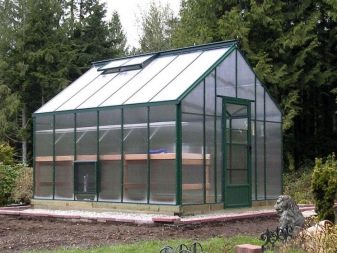
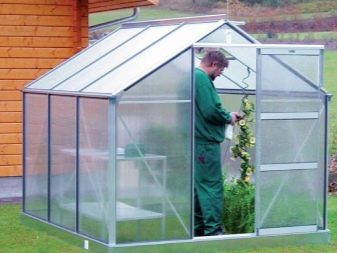
Greenhouses of unusual shapes are rarely used due to the fact that they are more difficult to make with your own hands and more expensive to purchase ready-made. Meanwhile, they are functional and easy to use. Non-standard types of greenhouses include:
"House" with inclined walls
This is a modified straight-walled structure of a house, which combines the advantages of a rectangular and an arched one. Due to the fact that polycarbonate walls are installed with an inward slope (small, 20 degrees), there is more space for planting beds. At the same time, the extended roof of the house provides hot air removal upward and free movement inside the building.
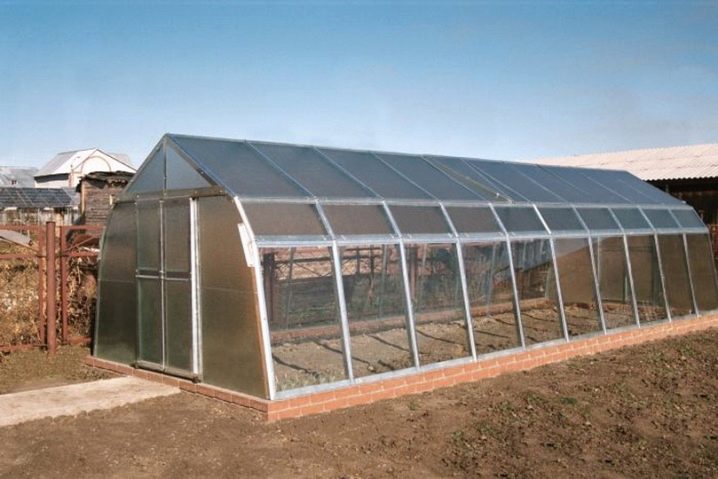
Sheathing inclined greenhouses with polycarbonate is more convenient than glass, since it is flexible, and more reliable than PVC film, since carbonate sheets are stronger.
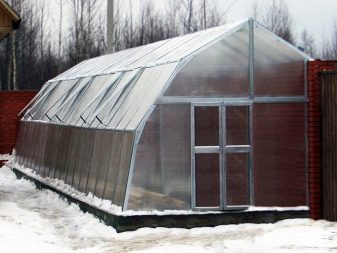
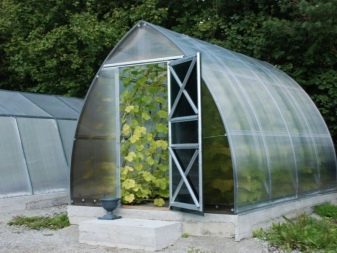
Geodesic dome
In addition to the fact that this spherical structure looks original in the garden, it has many advantages. The geodesic dome, due to the large number of edges in the structure, catches sunlight throughout the day. Inside it is well ventilated, and the aerodynamic shape helps protect against strong winds. The structure remains intact despite its low weight.
The disadvantage of such a greenhouse is that you can move around in it only if it is large enough.
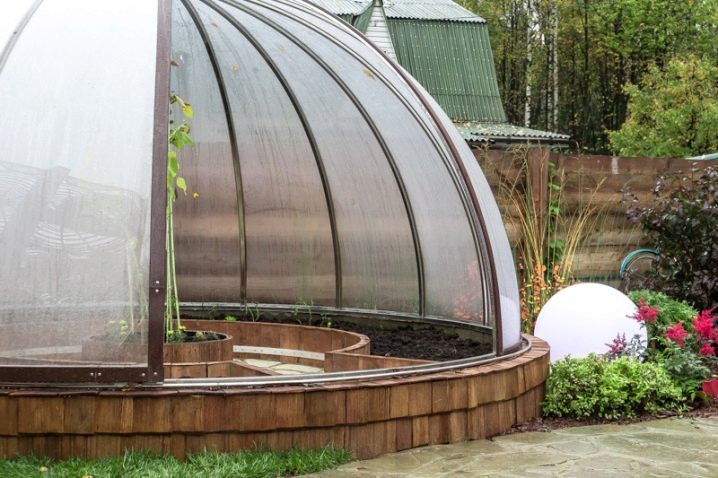
Meatlider's greenhouse
The discovery of the American gardener helped to solve the main problem of low greenhouses - poor air circulation. Plants literally dying and not breathing. The peculiarity of the design proposed by Meatlider is that the northern slope of the greenhouse is 30-45 centimeters lower than the southern one and is less steep. It connects to the southern slope like a step. From the outside, it looks as if two arched greenhouses of different sizes were divided in half and combined the smaller half with the larger one, fastened with a step on top. This step remains uncovered and air circulates through it.
In the conditions of the Russian climate, it is recommended to use a modified version - with closable ventilation. At the first severe frosts, plants will be damaged due to such an active supply of cold air.
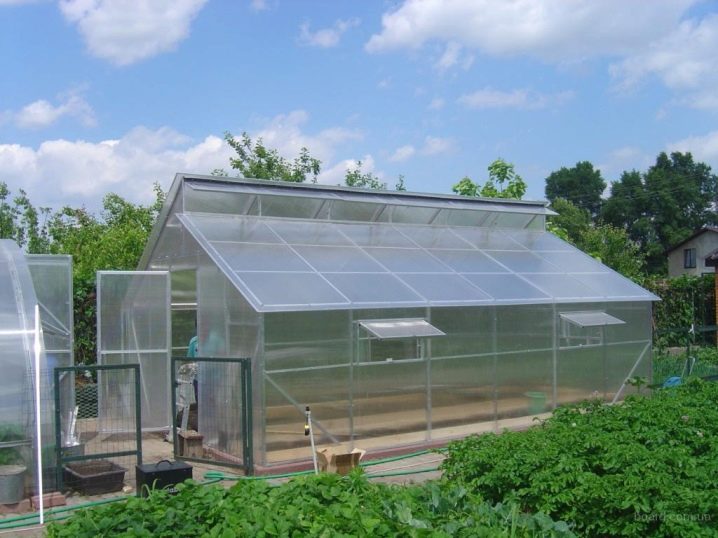
Vegetarian
In fact, it is the same as a back-to-wall greenhouse, but has its own blank wall. The result is a reinforced and reliable design with functional features.
Its main difference is that there is a reflective material on the blank wall. It doubles the sun exposure, which increases the efficiency of the greenhouse at a very low cost.
Mounting a veggie is more difficult than other types of greenhouses.
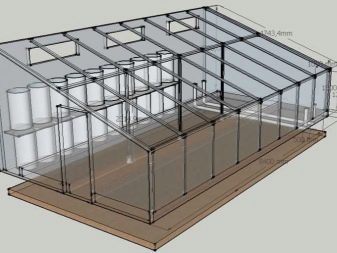

Drip
Such a greenhouse is similar in design to an arched one, but the central part of the roof is formed not by a smooth arc of a bent polycarbonate sheet, but by the joint of two sheets.
The roof in the structure is inseparable from the walls, since it is one sheet that bends smoothly from bottom to top, forming a streamlined triangle. The roof does not linger on it in winter, and the height allows a person to stand inside the attic at full height.
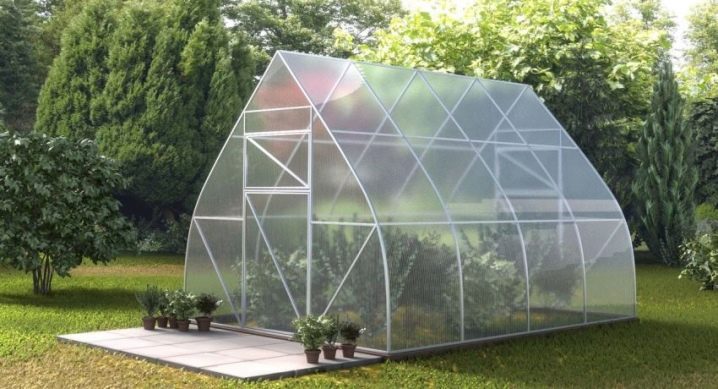
Roof
An important factor is the construction of the roof. They vary in shape and mobility.
Some roofs are stationary, that is, they do not have an opening mechanism, while others are sliding. They can be opened and closed depending on the weather conditions and the time of year.
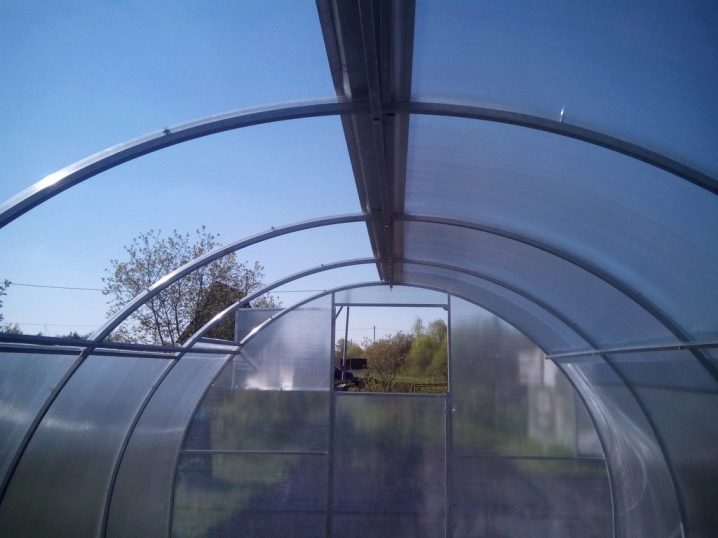
The roof can be of several types in shape.
- Shed. This option is related to wall greenhouses and Ivanov's vegetarians. Since one of the sides is a blank wall, there is no point in a gable roof. The arrangement of one slope simplifies the care of the greenhouse in the winter - snow does not linger on it.
- Gable. This is a classic version of the "house" greenhouse.The sharper the angle of inclination of the slope, the better the snow masses slide off the polycarbonate sheets in winter and the less the risk of damage to the structure from the severity of wet snow. The roof of a drip greenhouse can also be considered a gable. Although technically it is a single whole with the wall, it serves as a roof in the structure.

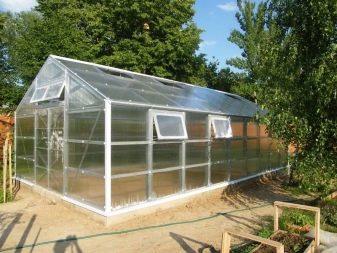
- Multi-slope. Such greenhouses are more reminiscent of four-, six- and octagonal gazebos. Their frame is usually made of wood, and transparent polycarbonate is chosen for cladding. The pitched roof allows the sun to penetrate evenly into the greenhouse throughout the day and does not accumulate snow.
- Mansard room. This roof option implies the large dimensions of the greenhouse. Structurally, this is a modified version of the "house", but with a smoother transition from the roof slope to the wall.
- Dome. Typical for spherical greenhouses. More often, the structure is perceived as a whole, without dividing it into component parts in the form of walls and roofs.

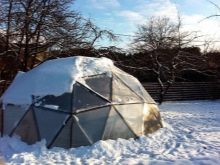
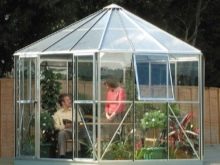
- Round. Its other name is arched. This is a greenhouse roof that is obtained by bending a sheet of polycarbonate. One sheet forms both walls and the upper part of the building at once. Its installation is the simplest, but its possibilities are also limited due to its low height.
- Removable. Greenhouses with a removable roof have not yet become widespread, but this is a profitable building in many respects.
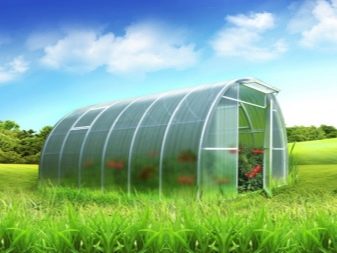
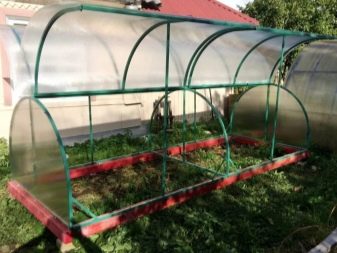
First of all, it will not suffer from a large amount of snow in winter. It will fall inside the building, from where it will be easy to remove it closer to spring.
And the fact that in winter the land will be under snow is an additional advantage for her. After all, snow is natural precipitation, and it protects the ground from freezing.
The removable roof also makes it easy to ventilate the greenhouse when the weather is hot.
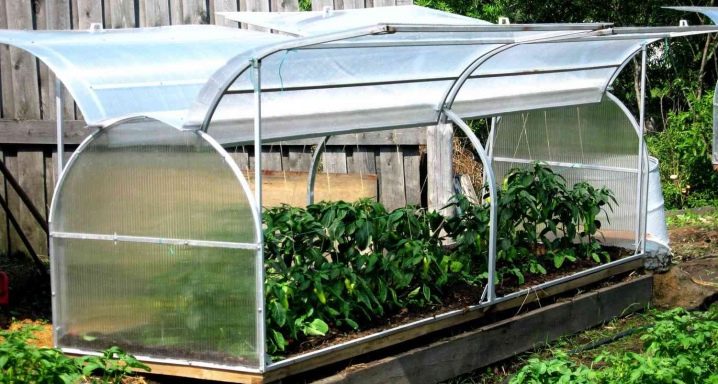
It is important to select the type of foundation and roof structure according to several factors. These include: dimensions and topography of the site, moisture and soil fertility, the type of climate in the region, the types of crops that will grow in the greenhouse. Not in all conditions the same greenhouse will be as efficient as possible.

Dimensions (edit)
In terms of overall dimensions, the greenhouse can be small, medium or large.
The division according to such criteria is very arbitrary, since it is necessary to take into account three main parameters: length, width and height of the structure.
The width of the greenhouse is a decisive factor. It is calculated by the number of beds that can be planted in parallel. Usually these are two - left and right, for a greenhouse of standard width. A small greenhouse should be at least 180 cm wide. It is important to take into account that there will be a door in the greenhouse, and the width of the doorway is designed for the parameters of an average person and is 50-60 cm.
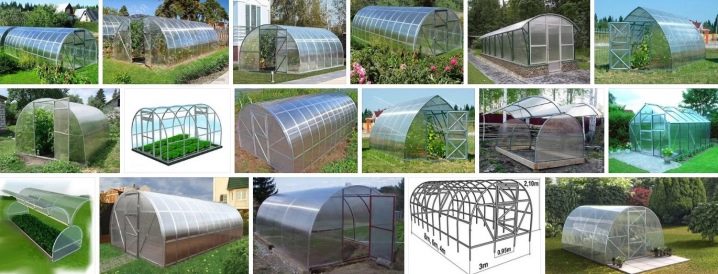
For a medium-sized structure, indicators of 240-340 cm are characteristic. Such greenhouses make it possible to equip a third bed in the center of the building.
A large greenhouse has a width of 340 to 440 cm. It can accommodate the largest number of beds and racks in 3 or 4 rows.
The height of the structure is equally important. So that in the greenhouse you do not have to work constantly in an incline, squatting or even on your knees, it should be of such a height that it will allow you to straighten up to its full height. The minimum value for the object height is 160 cm, the average value is 200 cm, and the high height is 250 cm.
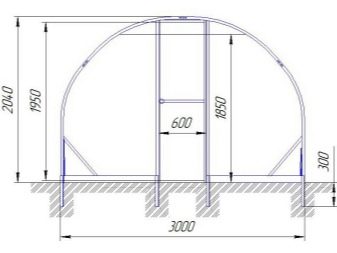
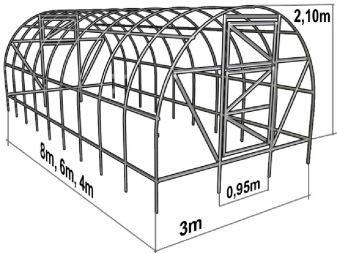
Tall greenhouses are more productive, since air circulates better in them and a microclimate that is most suitable for plant growth is created. And it is more convenient to work in them for a long time.
The height of the greenhouse is determined by the shape and width of the structure. The most convenient in this regard are greenhouses with a house, drip and attic.
The greenhouse can be of any length. The only condition is that it must be a multiple of an even number so that you can select the exact number of polycarbonate sheets without cutting them.
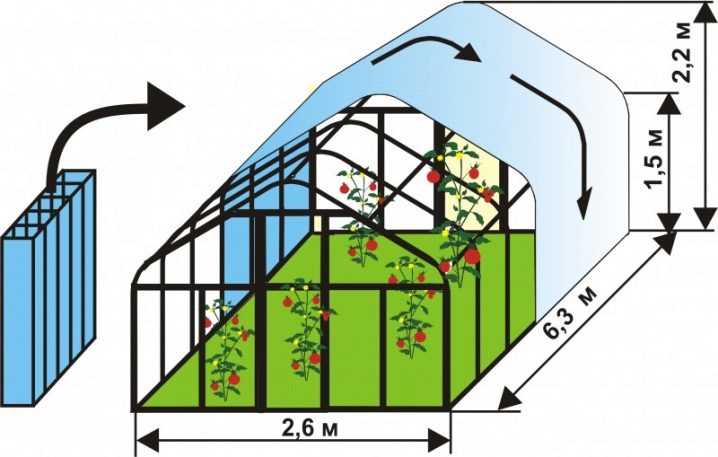
Another guideline is the size of typical pallets for planting greenery. This is necessary for those who do not want to form the beds on their own. Several pallets must fit exactly in the length of the greenhouse. Quantity is optional.
The length of a small greenhouse is only a few meters, an average one - 4-6, a large one - about 10. Do not choose too long a structure, since you will have to tinker with the arrangement of the foundation and the supply of heating and water.

It is important to take into account that the larger the dimensions of the structure, the stronger the frame must be and the more reliable the foundation.
In addition, with an increase in the size of the greenhouse, the financial costs for its arrangement and maintenance also grow. This applies to both building materials and systems inside the building: irrigation, heating, ventilation.

Additional materials
The set of materials for arranging a greenhouse, from foundation to ventilation, is relatively small. Let's start from the bottom up.
The first thing that will be needed in the work is alluvial river or quarry sand for a sand cushion under the foundation. Then you need sheet material for waterproofing so that the foundation does not collapse from groundwater. A thick polymer film with an overlap of 15-20 cm or bitumen paper is suitable.

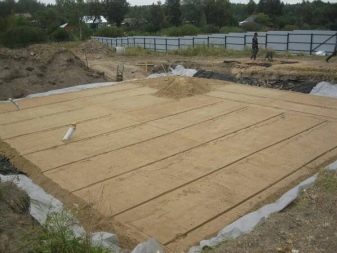
The foundation itself is selected depending on the type of frame. Wooden greenhouses require beams or impregnated sleepers and brick posts. For heavy structures, a concrete mixture of cement, sand and stone is suitable; for less weighty, brick and concrete pillars can be used without internal filling of the space.
For pouring the foundation, cement of a grade of at least M300 is suitable. It is desirable that it be resistant to moisture and freezing.
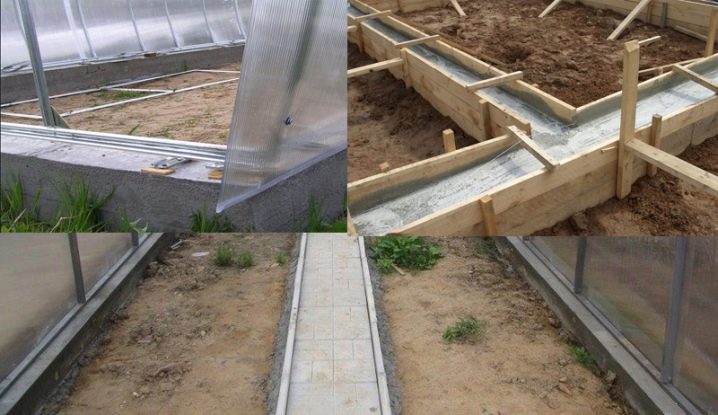
Next comes the frame itself. Polycarbonate works well with all types of materials.
If we are talking about self-assembly of the frame, the assortment to choose from is quite large.
- Lumber and wood. The wood is convenient for hand-made assembly. The frame will turn out to be strong and will have good thermal insulation qualities. But do not forget that wood is afraid of a large amount of moisture and does not belong to bio-resistant materials. It can be spoiled by pests and weather conditions, therefore, to protect the frame, the tree is impregnated with special protective compounds.
- PVC pipes and profiles. Lightweight, biostable and plastic material with low thermal conductivity. It is convenient to work with it, but greenhouses made of plastic of our own production are not very durable and resistant to stress. It should also be borne in mind that the plastic narrows and expands strongly with temperature changes, therefore, the design must provide for thermal expansion gaps. The factory-made plastic frame is more reliable and durable. The manufacturer gives a guarantee for it for a period of several years.
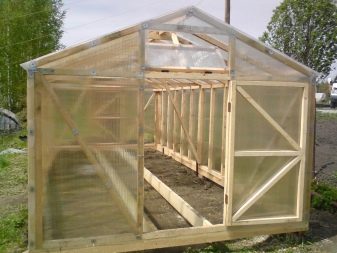
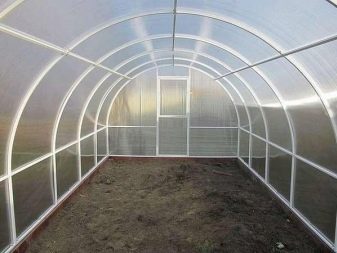
- Metal carcass. Galvanized pipes or profiles can be used here, for which a special machine will be needed to give the details of the structure the desired shape. More often, when they talk about a metal frame, they mean factory blanks. They are durable, stable, and have a long warranty period.
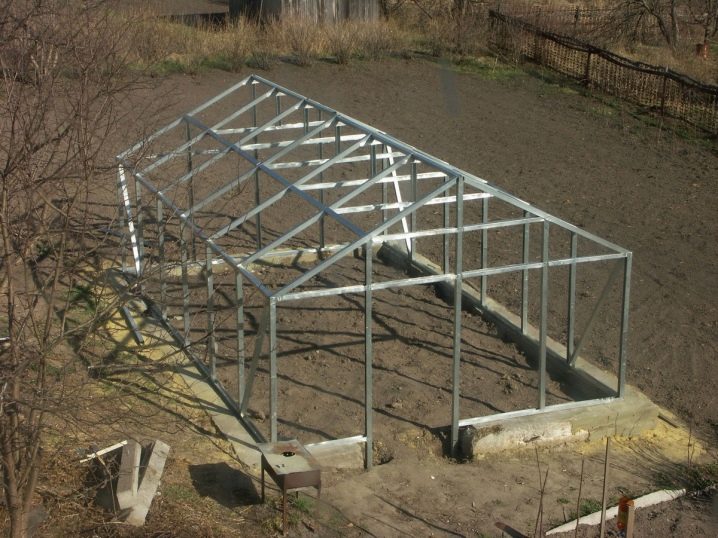
The strength of the frame is ensured by its correct assembly. A reliable structure that will withstand the snow mass in winter is made with a step of the profile forming it of 50-60 cm. The step can be less, but not more.
For cladding the frame, flexible sheets of light polycarbonate with a thickness of about 15 mm are needed. Preferred cellular polycarbonate, between the sheets of which there are vertical and inclined ribs of cruelty.
Polycarbonate alone is not enough for cladding. In addition to him, you need a sealant for sealing the sections so that moisture does not get into them, and fasteners.
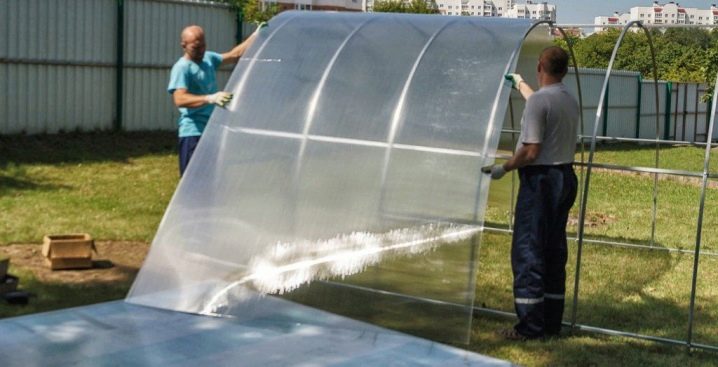
Carbonate is fixed in two ways. For the first, you need a special profile. The carbonate sheet is inserted into the groove, then the profile is attached to the frame with self-tapping screws. You need to be careful with such a mount, as polycarbonate will expand and contract with temperature changes.If inside the profile it is stitched with a self-tapping screw without a reserve for expansion, then in the future a crack may form in this place.
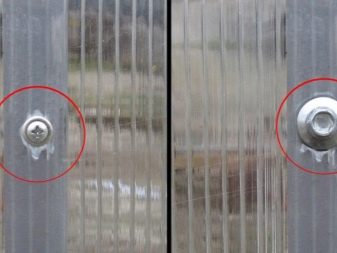

The second method involves the use of the so-called "thermal washers" and waterproofing. It is more complicated and more expensive, but more reliable.
For the complete assembly of the structure, you will need more accessories (hinges, handles, opening and closing mechanisms) for arranging doors and ventilation holes.
Some gardeners will end up covering the structure with protective agents in order to extend the lifespan. It is important not to overdo it here, because the greenhouse is important not in itself, as a structure, but as a functional building.
It is necessary to choose such protective coatings (films or aerosols) that will not interfere with the penetration of sunlight into the greenhouse, to the plants.
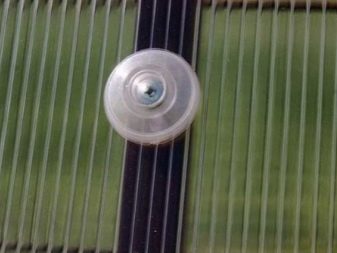

Required tools
To prepare for installation and the implementation of the process itself, you may need drawing tools, a tape measure and a building level. They are needed to install the guides for self-assembly of the frame and its sheathing.
So that the polycarbonate sheets do not go at random, the first of them should be installed as evenly as possible.
To cut sheets, you need a circular saw so that the carbonate sheet does not crumble, but turns out with an even and straight cut. If you don't have a saw, a sharp construction knife will do.

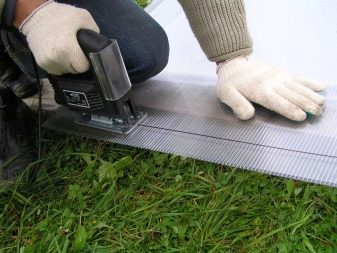
After the sheet is cut, the carbonate chips must be removed from the inside. This can be done with a vacuum cleaner.
To attach the frame to the foundation, you will need a drill and anchor bolts. For sheathing the frame, you need a screwdriver, since the drill for this has excessive power and number of revolutions. It is better to choose a cordless screwdriver and have a spare battery for it, since one charge is not enough for a full frame covering.
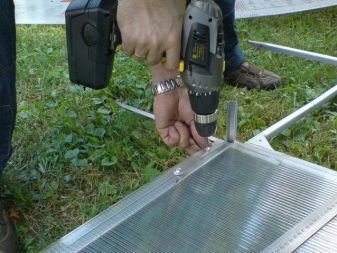

When covering a tall greenhouse, you will need a stable ladder. A screwdriver, a carpentry hammer and a rubber hammer may come in handy. Also, do not forget about basic protective equipment: gloves, glasses (when cutting sheets) work clothes, comfortable shoes.

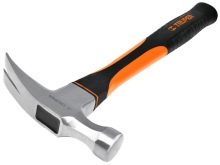

How to sheathe?
Professional installers recognize the most reliable type of polycarbonate fastening to be mounted on thermal washers. These are fastening parts, which are a structure of an o-ring, a body and a protective cap. The screw is screwed into a special hole in the center of the case, and is closed with a cap on top.
The "body" of the washer can also be made of rubber. Such washers are more expensive but more effective. When using them, the polycarbonate is protected from cracking in the place where the screw is screwed in. A gap remains under the rubber O-ring to allow for the expansion of the material with increasing temperature, and at the same time it does not allow warm air to escape through the holes in the mount, and water from entering.

Thermal washers are available in different diameters, thicknesses and colors. The last parameter is not so important, it is responsible for the aesthetic function, but the diameter should overlap the hole in the sheet by a few millimeters. The O-ring should be chosen with a thickness of at least a few millimeters.
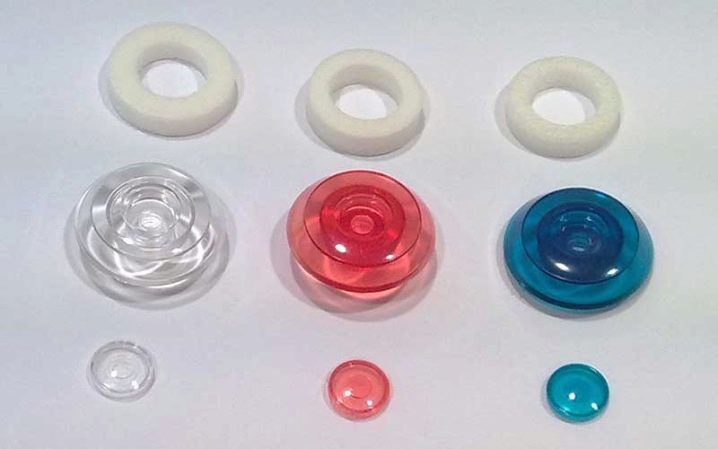
When the materials are selected, you can proceed to the cladding.
The process is carried out step by step.
- Preparatory work. At this stage, it is necessary to check whether the greenhouse body is in order, whether there are any damages on the polycarbonate sheets. All materials are installed exceptionally dry in warm and dry weather.
- Cutting out sheets. This step is not always necessary. For example, for an arched greenhouse, it is enough to purchase sheets of carbonate of the length that is necessary to form the walls and roof at the same time. You will have to tinker with greenhouses of more complex shapes, measuring the desired size of fragments, drawing their contours on a sheet and cutting them out with a grinder or a construction knife.
- Slicing processing. If polycarbonate sheets are not mounted using a dense profile, into which the sheet fits tightly, then sections with open "honeycombs" are treated with a sealant. This is necessary so that moisture, dust and insects do not get inside. The liquid sealant can be replaced with tape.
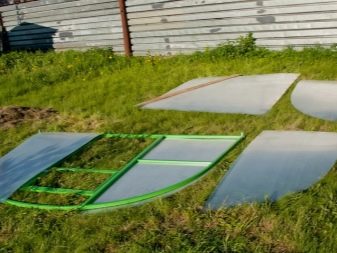
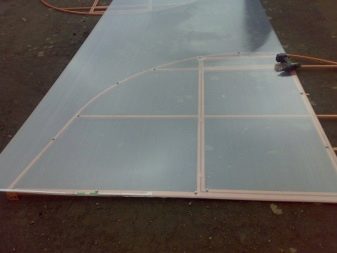
- Hole markings. Ready-made fragments for cladding are applied to the hull. This work must be done with at least four hands so that the sheets do not slide off when the markings are applied to them.
- Drilling holes. Screwing the self-tapping screw directly into the sheet and frame is a big mistake. First you need to determine with what step and at what points the fasteners will be fixed. Then drill a hole with a large diameter drill bit, which will be larger in size than the diameter of the screw. Only then can the sheets be applied to the frame and fixed.
- Sheathing. Fragments of polycarbonate are mounted alternately using a screwdriver and fasteners. The self-tapping screw must be screwed into the body perpendicular to the frame, not obliquely. Each fastener must be checked immediately, since dismantling the sheet will take a long time, and it will be possible to reuse it only with minor damage around the holes.
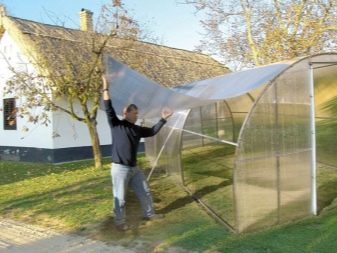
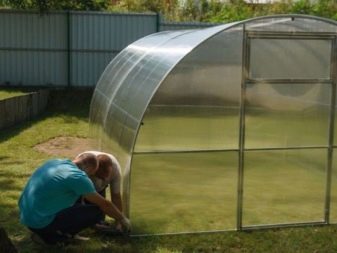
An alternative mounting option is profiles. They are detachable and one-piece, wall-mounted, end, ridge and corner. Profiles are used for joining cladding elements, separating and sealing.
Profiles have several advantages: they make it possible to assemble parts of the structure on the ground, and then connect them around the frame as parts of the constructor, securing them with fixing elements. Replacing them is also easy. When using profiles, there is no need to cover the sections with a sealant. They are suitable for covering complex greenhouses, but not for arched greenhouses.
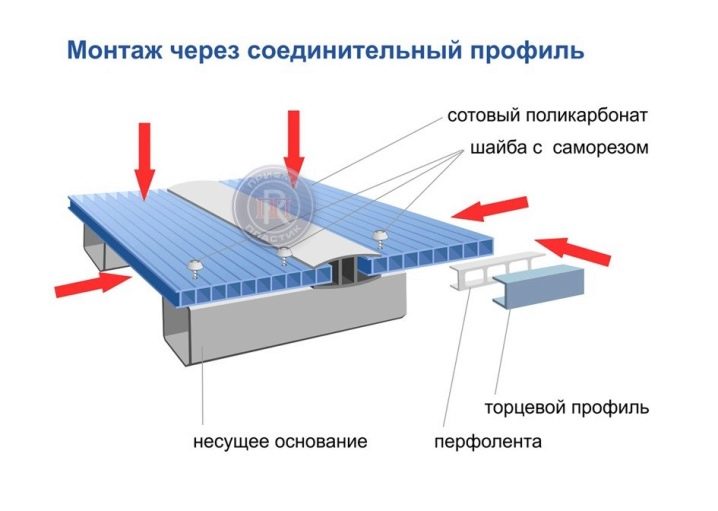
The disadvantages include the high cost of the structure with fastening profiles and the complexity in the calculation of parts.
Profiles are made of the same polycarbonate or aluminum.
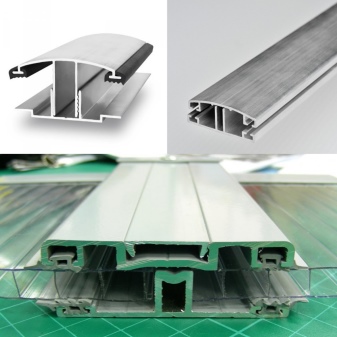
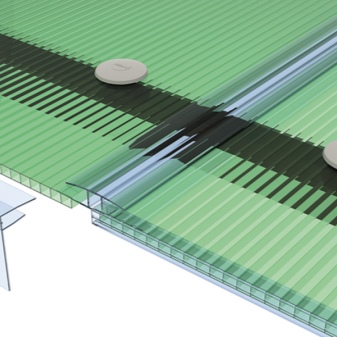
Internal organization
Greenhouse cladding is only half the battle. For its effective use, it is important to properly equip the space inside: choose the size and location of the beds, organize an irrigation system or water supply, lighting and heating.
Artificial lighting in the greenhouse is carried out as in any other utility room in the country. The main challenge is to choose the right type of bulbs for your lighting.
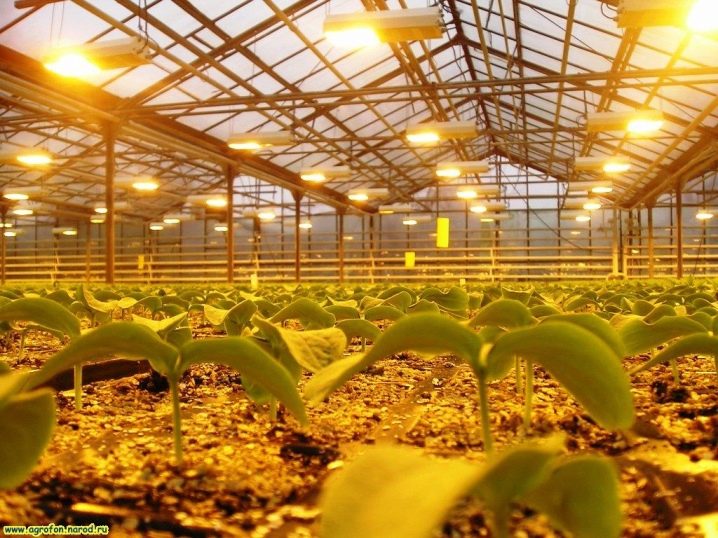
Types of lamps.
- Incandescent lamps. The cheapest, but rapidly outdated option. Its advantages are pleasant yellow light and low price. They have much more disadvantages: a fragile glass bulb that does not withstand temperature and humidity changes in the greenhouse, a short service life, a high degree of heating.
- Halogen. It differs from its previous prototype in a more complex internal structure, therefore it lasts longer, but for greenhouse conditions it is not the best option.
- Luminescent. Such lamps are also called energy saving. They have a solid body and a comfortable shape - elongated tubes. They last longer, but emit harmful rays, and mercury vapors are used in their creation. If such a light bulb breaks in the greenhouse, the consequences will be unpleasant.
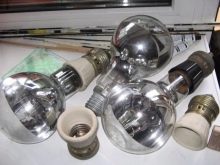
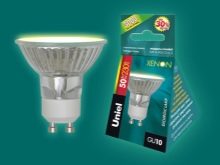
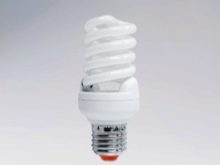
- LED. LED lamp - lighting device of the latest generation. It wins in energy efficiency, economy, resistance to use in a greenhouse microclimate, long service life. There is one drawback, but it pays off over time - the high cost of LEDs.
Lamp selection isn't everything. In order for the lighting to be safe in a greenhouse, where there is constant dampness, you need to take care of high-quality insulation of the wiring. It is best to install protective boxes and mount them at the top of the walls.

Watering
Plant irrigation and watering can be done manually and automatically.For manual irrigation, you need a container with water and a hose with replaceable nozzles, and for automatic irrigation, a complex mechanism that works only when necessary. In this case, temperature and climate sensors are installed inside the greenhouse, and when the level of humidity and heat becomes too high, the irrigation mechanism is activated.
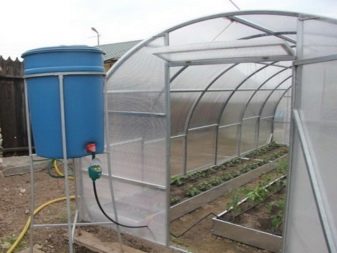
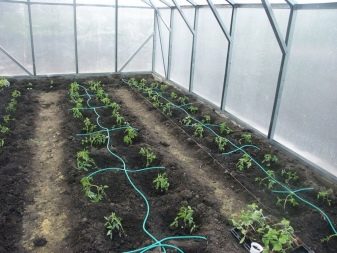
In addition to making it easier to care for your plants, there are other benefits to automatic watering. For example, the ability to heat water to a certain temperature at different times of the year or supply water in individual portions for unpretentious and capricious plants.
There are three irrigation mechanisms: "Sprinkling", subsurface system, drip system.
Sprinkling is one of the simplest methods. It should be considered, rather, semi-automatic due to the nature of the device.
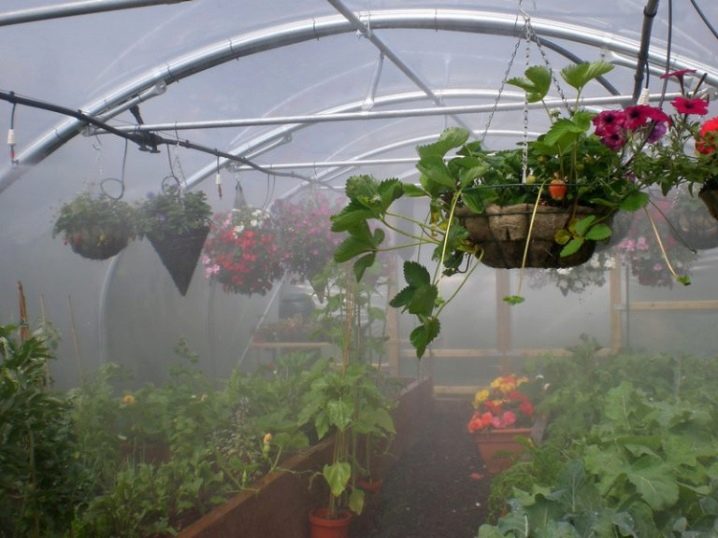
When sprinkling, the sprayers are mounted above the flower beds, and if necessary, they are connected to the hose for irrigation. Water goes through a hose to the spray nozzles and irrigation occurs. The involvement of the grower is kept to a minimum.
The drip system is intended for this type of summer cottage, where water is supplied once or twice a day at certain hours and it is not possible to use it for irrigation in unlimited quantities. The water for such a system is stored in a barrel that needs to be replenished regularly.
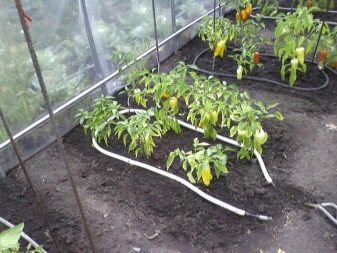
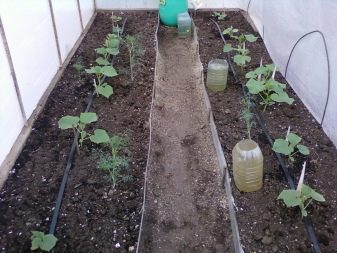
A complex soil water supply system is provided for capricious plants. It consists of pipes or hoses along the beds with drainage systems for each bush. Through thin tubes, water is supplied to each plant separately.

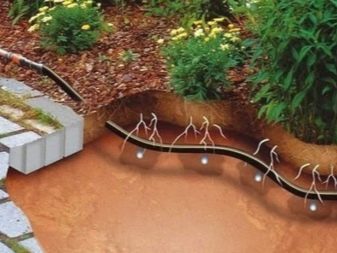
Heating
The presence of a heating system is what distinguishes a greenhouse from a greenhouse and makes it possible to start earlier and finish harvesting later. It is important not to miscalculate with the choice of the system.
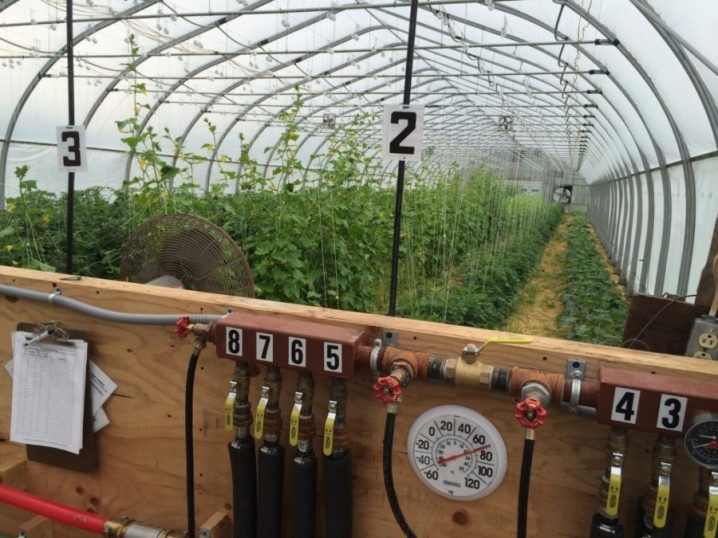
It can be of several types.
- Air. This is the use of thermal cushions in the form of fans that are attached at a certain distance inside the greenhouse. They quickly warm up the room, maintain the desired temperature and are easy to operate. The temperature can be controlled as precisely as possible. The disadvantages of air heating are that the system is dependent on electricity and has significant energy costs. Also, constant streams of warm air violate the microclimate, drying it out.
- Water. This method involves the installation of iron or PVC pipes through which hot water flows. The water system should simply be connected to the communications in the house, otherwise it will be expensive and problematic to lay and connect it.
- Gas. Gas heating is cheap and efficient, but unsafe. Installing gas pipes in a room that freezes and overheats and where active gardening is underway is a risky undertaking.
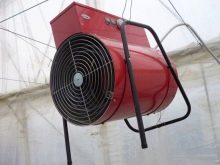
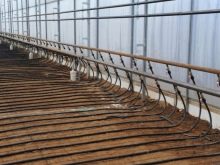
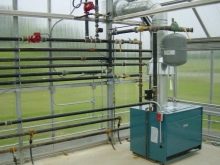
- Cable. A modern and efficient system, which in its structure resembles a cable floor heating. Heats the soil quickly and evenly, but the energy consumption for maintaining the system is too high.
- Radiator. Alternative option to air heating. As a source of heat, ordinary country radiators, powered by the network, act. They quickly warm up the room, but consume a lot of energy, and give off heat unevenly. The air near the radiator will be several degrees warmer than in the distance.
- Infrared. The most modern and reliable system. It not only heats the greenhouse well, but also emits long-wave UV rays that are useful for plant growth, and disinfects the air. Installation of an IR system will cost more than any other, but its energy consumption is the smallest, and its service life is long.
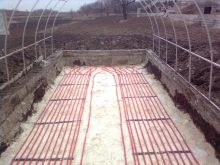
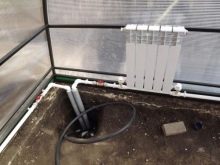
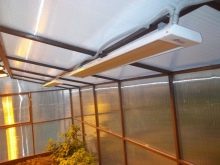
When choosing a heating system, it is worth taking care that the pipes in the ground do not freeze through, the electric wires are not exposed to moisture, and the radiators and fans do not harm the plants.
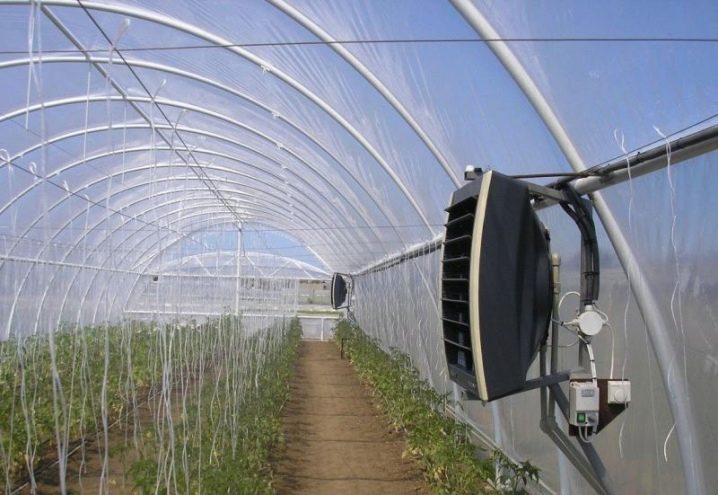
Tips & Tricks
A garden greenhouse will last a long time and will delight you with a good harvest from year to year, if you correctly approach the choice of materials and type of construction.
Experienced gardeners recommend following several important rules when choosing the right greenhouse.
- Choose polycarbonate with a thickness of at least 5 mm. This material is suitable for arched greenhouses. For structures that do not require maximum sheet flexibility, it is worth choosing a material with a thickness of about 10 mm with combined stiffeners.
- Carefully choose a place on the site for placing a greenhouse. The most suitable is a site that is not shaded by trees or shade from a country house, is as closed as possible from the wind and does not have large relief drops.
- Polycarbonate for the greenhouse must have a protective layer against ultraviolet rays.
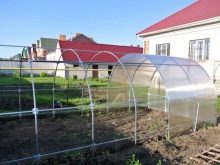
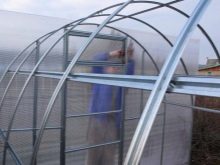
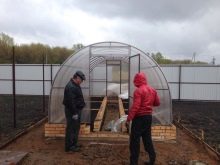
- Trying to save money on material is notoriously a bad idea. Quality polycarbonate cannot be cheap. A cheap product is a fake that will become unusable in one season.
- Always build a greenhouse on a foundation. Newbie gardeners are often tempted to install the framework directly into the ground. This is not worth doing, otherwise the greenhouse will not survive the first winter.
- Always treat sections with sealed tape or mortar.
- Do not screw in self-tapping screws without thermal washers.


- To accurately determine the size of the hole for the screwdriver with a margin for expansion, it is necessary to sheathe the case with polycarbonate at a temperature of +10 degrees. At this time, the material is in its natural state.
- The greenhouse must have ventilation at the top of the structure.
- Purchase materials from trusted manufacturers who can confirm the quality of the goods with customer reviews and relevant certificates.
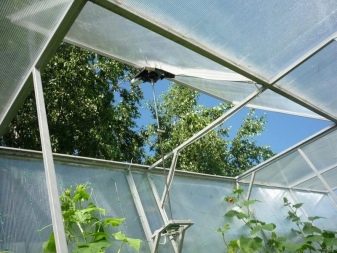
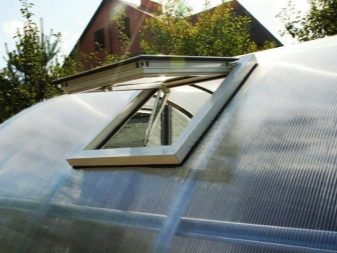
How to care?
Greenhouse maintenance is important because it affects both its efficiency and its lifespan.
First of all, care measures concern the appearance of the building. By the end of the gardening season, dust and dirt from the inside and outside accumulates on the polycarbonate greenhouse. It is recommended to remove it not only so that the greenhouse has a neat appearance, but also so that sunlight can freely pass into the building.
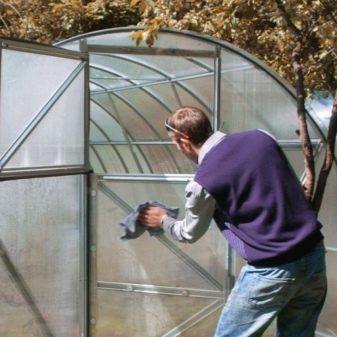
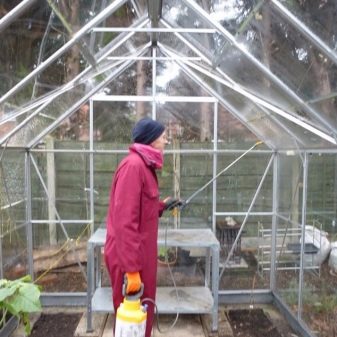
The top layer of polycarbonate does not tolerate the aggressive effects of alkaline and abrasive materials. They cannot be used when washing the structure.
Scratches and stains will remain on the surface.
In winter, the main concern of a good gardener is to prevent snow and ice from accumulating on the roof of the greenhouse. They are very heavy and can damage the polycarbonate. To reduce snow problems, it is recommended to choose greenhouses with a steep roof slope or a streamlined shape. If the roof of the building is flat or arched, then it must be regularly cleaned of snow masses.

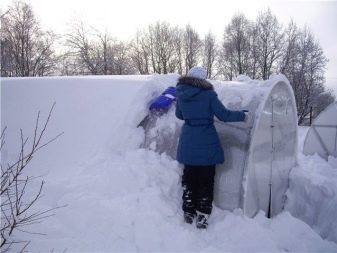
Reviews
Reviews of experienced and novice summer residents mostly speak in favor of polycarbonate greenhouses. Among the advantages, they note the ability to start planting seeds and greens earlier, and an increase in productivity. The housewives are pleased that in the presence of a greenhouse there is less work with the beds, because the soil inside can be prepared in the fall, and in the spring, the seedlings can be planted at a convenient time.
The advantages include the ease of assembly of the structure and low prices for ready-made greenhouse frames.

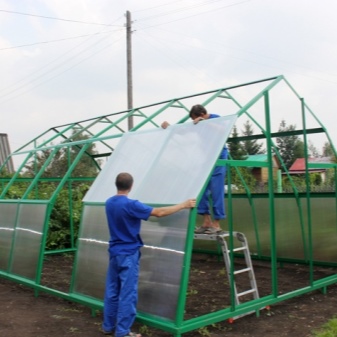
The classic greenhouse "house" is recognized by most as the most resistant to weather conditions and harsh wintering without much maintenance.
There is also a negative share of reviews. As a rule, these are complaints from craftsmen, whose work on the cladding could not withstand the load of snow and wind in winter.
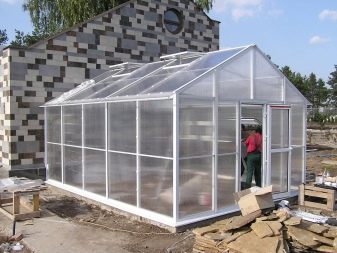
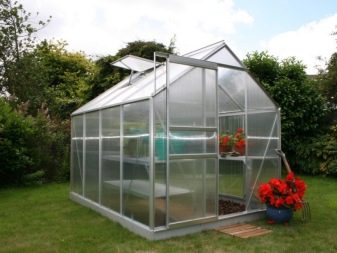
Beautiful examples
A good gardener will not allow himself to build an unprepossessing-looking greenhouse on the site. It will not work to hide this building behind the house or in the thickets of trees, it should be in the most open and lighted place. It remains to choose a beautiful design for her.


In order for the greenhouse to serve not only a practical, but also a decorative purpose, it must harmoniously fit into the landscape design of the garden plot.This means that you need to choose a greenhouse design style in accordance with the style of a country house or plot.
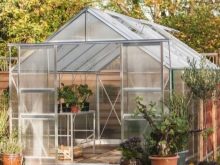
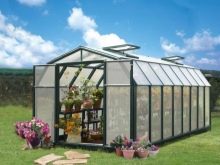
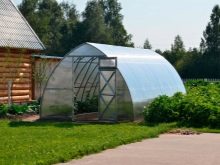
If the garden belongs to one of the classic options, it is recommended to use simple and understandable symmetrical shapes and polycarbonate in a discreet color.
Transparent, pastel, green will do. More modern areas require geometric shapes, sharp corners, functionality and transparency. For example, you can make sloped walls a prominent structural feature.
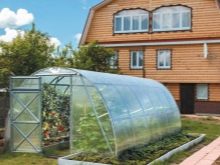
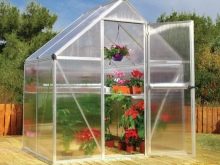

For country, Provence or rustic homes, warm and vibrant colors are suitable. You can use drawings on the walls, windows and roofs of an unusual shape, plant flowers nearby.
You can combine the greenhouse into one ensemble with other buildings by using polycarbonate as the roof of a gazebo, veranda, summer house.
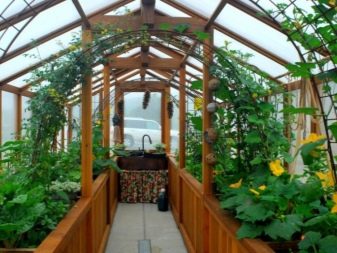
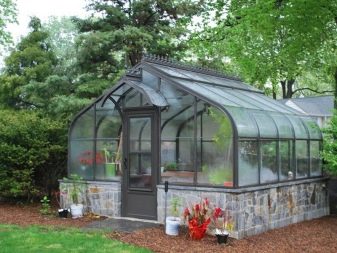
For information on how to independently assemble a polycarbonate greenhouse, see the video below.





























































The comment was sent successfully.